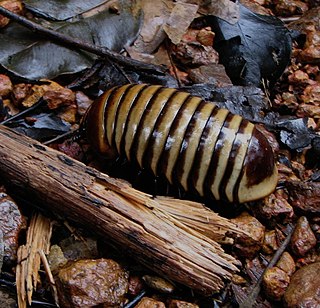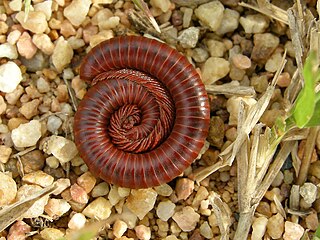The wildlife of Sri Lanka includes its flora and fauna and their natural habitats. Sri Lanka has one of the highest rates of biological endemism.

Arthrosphaeridae is a family of giant pill millipedes that are found in Madagascar, the Western Ghats of India, and Sri Lanka. The largest pill-millipede in the world, Zoosphaerium neptunus belongs to this family and is known to swarm at certain times of the year.
Lankasomatidae, is a millipede family in the suborder Heterochordeumatidea of order Chordeumatida. The family includes 11 species belongs to three genera.
Lankasoma anderssoni is a species of millipedes in the family Lankasomatidae. It is endemic to Sri Lanka.
Lankasoma cederholmi is a species of millipedes in the family Lankasomatidae. It is endemic to Sri Lanka.
Lankasoma oreites is a species of millipedes in the family Lankasomatidae. It is endemic to Sri Lanka.
Lankasoma mahleri is a species of millipedes in the family Lankasomatidae. It is endemic to Sri Lanka.

Anoplodesmus anthracinus is a species of millipedes in the family Paradoxosomatidae. It was previously thought to confined to Myanmar, the species was reported and documented from Malaysia and Sri Lanka in 2013.
Anoplodesmus humberti is a species of millipede in the family Paradoxosomatidae. It is endemic to Sri Lanka, which was first documented from Peradeniya.
Anoplodesmus layardi is a species of millipedes in the family Paradoxosomatidae. It is endemic to Sri Lanka, which was first documented from Peradeniya.
Anoplodesmus luctuosus is a species of millipedes in the family Paradoxosomatidae. It is endemic to Sri Lanka, which was first documented from Ramboda. The species sometimes placed in the genus Polydesmus of the family Polydesmidae.
Anoplodesmus inornatus, is a species of millipedes in the family Paradoxosomatidae. It is endemic to Sri Lanka, which was first documented from Peradeniya.
Anoplodesmus sabulosus, is a species of millipedes in the family Paradoxosomatidae. It is endemic to Sri Lanka, which was first documented from Kandy.

Anoplodesmus saussurii is a species of millipedes in the family Paradoxosomatidae. It was once thought endemic to Sri Lanka, but it was later found in Fiji and Mauritius.
Paranedyopus simplex, is a species of millipedes in the family Paradoxosomatidae. It is endemic to Sri Lanka, first documented from Pundaloya. The species is greatly differ from other members of the genus due to reduced paraterga and more elaborate gonopods.
Leptodesmus thwaitesii, is a species of millipedes in the family Chelodesmidae. It was once thought endemic to Sri Lanka, where first documented from Peradeniya.
Chondromorpha xanthotricha, is a species of millipedes in the family Paradoxosomatidae. It is native to South India and Sri Lanka. Two subspecies recognized.
Arthrosphaera brandtii, the Tanzanian pill bug millipede, is a species of pill millipede in the family Arthrosphaeridae. It is found in many African and Asian countries including India and Sri Lanka. Mature individuals of the species reach 3–4 cm in length. Adults are pale brown in colour with black lines in between the segments, whereas juveniles are dark brown. The species is one of the most commonly kept giant pill millipede species within the exotic pet keeping hobby. An introduced population of Arthrosphaera brandtii exists on the Usambara Mountains of Tanzania.

Thyropygus allevatus, the Siamese pointy-tailed millipede, is a species of round-backed millipede in the family Harpagophoridae. It is found in Sri Lanka, Thailand and Vietnam.



